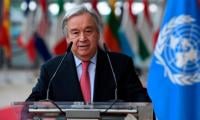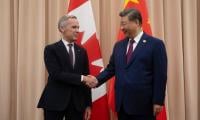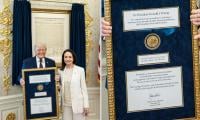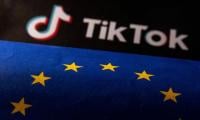Telecom sector to show 8pc growth in FY2022
Karachi: The telecom sector’s market size is estimated to go up by Rs51 billion or 8 percent to Rs695 billion by the end of fiscal year 2022 against FY 2021, according to the Pakistan Credit Rating Agency. This rise can be associated with the expansion of 3G, 4G and 5G services in Pakistan.
In the aftermath of Covid-19, broadband data usage increased by 52 percent during FY21. The increased internet usage also had a significant impact on the sector’s financial outlook.
As per the Securities and Exchange Commission of Pakistan (SECP), the principal line of business of the companies in the telecommunication sector was to carry on all or any of the businesses of establishing, developing, expanding, enhancing, managing and operating telecommunication systems including systems signals, data or messages of any and all kinds.
In Pakistan, approximately 98 percent of the households own a mobile phone, whereas penetration of mobile services was 88 percent at the end of February 2022 with nearly 192 million mobile subscriptions.
Pakistan government is in the process of refining modalities for launch of 5G in the country. In addition enhanced consumer welfare, innovative entrepreneurship, and startups in the ICT sector are also expected as well as economic growth in the ICT sector.
However, some industry players were against the government’s decision to expedite roll out of 5G technology because “Pakistan’s infrastructure was not ready for it for at least the next two years”, they said.
A section of the country’s population does not have access to any kind of mobile or telecom services, and around half of Pakistan's population also lacks the internet.
Industry players said that the priority should be delivering 4G to every Pakistani, as only a small section of the population could afford a 5G handset. Moreover, spending money on a technology that was only available to the rich would not be a good decision at the moment, they added.
The combined number of 3G/4G subscribers in Pakistan has reached 113 million with a CAGR of 25 percent since fiscal year 2017. The growth in total subscribers has been led by the growth in 4G subscribers. Backed by the availability of affordable 4G supported devices, share of 4G subscribers is expected to increase further.
Jazz is the market leader in 4G subscribers with a share of 39 percent followed by Zong having 30 percent share by the end of February 2022.
By February 2022, Total borrowings of the sector reached Rs180 billion – 29 percent higher than Rs140 billion, which were for the same period last year.
Considering the high capital intensive nature of the sector, a major portion of the sector’s borrowing – 88 percent is long-term, while the portion of short-term loans is only 6 percent.
The Global Mobile Industry Association (GSMA) has recently criticised the 100 percent cash margin restriction on imports imposed by the State Bank of Pakistan. It has asked the government to remove it for telecom equipment to avoid jeopardising current and future network roll-out.
In a budget proposal letter to the Federal Board of Revenue, GSMA has also asked for custom duties to be reduced on batteries used for telecom infrastructure to encourage green energy use.
GSMA has proposed gradual abolishment of advance income tax (AIT or withholding tax) on essential telecom services in the FY2022-23 budget.
GSMA recommended tax reforms, including the reduction of AIT from 15 percent to 8 percent and repealing the increase in AIT rate made through the Finance (Supplementary Act) 2022 to accelerate the digital economy.
It said mobile consumers face a high-level of sector-specific taxes in addition to general taxes. Sales tax was 19.5 percent on mobile services, with 15 percent AIT, among the highest in the region.
Such a reduction of consumer taxes would generate higher government tax revenue and GDP in the medium-term.
It said the AIT was particularly regressive given many low income users were not required to, and do not, file their tax returns and therefore could not claim refund. Therefore, the application of this tax only disproportionately added to the cost of mobile ownership for poorer individuals, further deepening the gap in mobile ownership and usage.
Over the past decade, the mobile sector in Pakistan has expanded rapidly, enabling life-enhancing benefits such as financial inclusion via mobile money, access to educational resources and connected businesses.
As highlighted by the Prime Minister’s Digital Pakistan Vision, the mobile sector plays a critical role in the development of the country’s economy and its digital transition.
However, there remains a significant unconnected population in terms of unique subscribers.
GSMA estimates that about half of Pakistan’s population (43 percent unique-subscriber penetration) remains unconnected to a mobile network and only 30 percent population (unique penetration) are using mobile internet services. This was lower than the average in South Asia.
Tax contribution of the mobile sector in Pakistan remains considerably higher than the average for Asia and other regional averages, which constrains mobile operators’ ability to invest in connectivity, as well as the availability and affordability of mobile services to consumers.
In 2020, the total tax contribution of the mobile sector, amounted to Rs170 billion ($1.1 billion), equivalent to 38 percent of mobile sector revenues. Furthermore, this was substantially higher than the Asia Pacific average (24 percent) and the global average (22 percent).
-
 Taiwan, TSMC To Expand US Investment: A Strategic Move In Global AI Chip Race
Taiwan, TSMC To Expand US Investment: A Strategic Move In Global AI Chip Race -
 UN Chief Lashes Out At Countries Violating International Law; Warns 'new Geopolitics' Could Jeopardize World Order
UN Chief Lashes Out At Countries Violating International Law; Warns 'new Geopolitics' Could Jeopardize World Order -
 Carney Meets Xi In Beijing: Key Developments Revealed In The New Canada-China Trade Roadmap
Carney Meets Xi In Beijing: Key Developments Revealed In The New Canada-China Trade Roadmap -
 WhatsApp Adds New Status Privacy Check For Who Can See Your Updates
WhatsApp Adds New Status Privacy Check For Who Can See Your Updates -
 Prince Harry Takes On Dangerous Mission In 2026
Prince Harry Takes On Dangerous Mission In 2026 -
 Trump Accepts Nobel Peace Medal From Machado: What It Means For Venezuela Politics?
Trump Accepts Nobel Peace Medal From Machado: What It Means For Venezuela Politics? -
 Late-night Snacking Linked To Higher Risk Of Liver Disease
Late-night Snacking Linked To Higher Risk Of Liver Disease -
 John Mellencamp Gives Update On Daughter Teddi's Health Struggles: 'She's Suffering'
John Mellencamp Gives Update On Daughter Teddi's Health Struggles: 'She's Suffering' -
 ‘Disturbing Developments’ Start To Follow Prince William, Kate: ‘This Has The Makings Of A Crisis’
‘Disturbing Developments’ Start To Follow Prince William, Kate: ‘This Has The Makings Of A Crisis’ -
 Pamela Anderson Breaks Silence On Fallout With Ex-Tommy Lee: 'I Miss Him'
Pamela Anderson Breaks Silence On Fallout With Ex-Tommy Lee: 'I Miss Him' -
 Andrew Warned: ‘You’re Gonna Add Your Own Final Nail In The Coffin Of Reputation’
Andrew Warned: ‘You’re Gonna Add Your Own Final Nail In The Coffin Of Reputation’ -
 Ben Affleck Doesn't Want His Kids To Join Showbiz: Here's Why
Ben Affleck Doesn't Want His Kids To Join Showbiz: Here's Why -
 George R.R. Martin Calls 'House Of The Dragon' S3 'not My Story'
George R.R. Martin Calls 'House Of The Dragon' S3 'not My Story' -
 Jessi Ngatikaura Gets Real About ‘identity Crisis’ From Facial Surgery
Jessi Ngatikaura Gets Real About ‘identity Crisis’ From Facial Surgery -
 Timothy Busfield Faces Potential 15-year Prison Sentence If Convicted
Timothy Busfield Faces Potential 15-year Prison Sentence If Convicted -
 Kim Kardashian Gushes Over 'baby Girl' Chicago As She Turns 8
Kim Kardashian Gushes Over 'baby Girl' Chicago As She Turns 8



